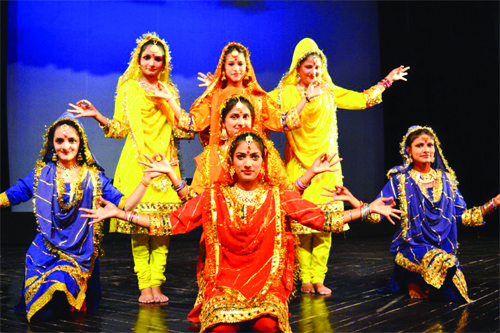Ashok Sharma
The land of Dogras called Duggar is famous for its rich culture and heritage bequeathed to us by our forefathers.We have a variety of folklores, folksongs and folkdances which bear testimony to our rich culture since the days of yore. One such folklore is Gagail which is organised on the auspicious occasion of Nagpanchami or Janamasthmi in many regions of Duggar.It is organised to please the family deity or Kuldevta every year or to offer sacrifices and offerings to Kuldevta on the eve of birth of a child or marriage or after a fixed period of one or four years. On the day of Gagail,the drum beaters or Gardis, who are well versed with the rituals of performing sacrifices or sthapana of the deities , are invited . They sing kaaraks (which are considered to be the equivalent of the English word ‘ballad’) or hymns in glory of deities, eulogising the birth, life and heroic deeds of gods and deities in their unique style.They possess profound knowledge of the life and heroic deeds of these deities bequethed to them by their forefathers through oral words rather than the written words.They invoke the deities by singing their heroic deeds and seeking their blessings.It makes the dualas,who are believed to have miraculous supernatural powers pass into a trance. They become frenzied and shake their body/body parts uncontrollably during the dance and act as medium between the Deity and the people, communicate the commands of the Deity regarding their own welfare or general good of the village.
He calls the names of the family /clan deities such as Kaliveer, Raja Mandlik who was famous for meeting out justice to his subjects,saints such as Sidh Gouria, Gorakh Nath, Baba Jitto-the tiller who protested against the injustice of his landlord Mehta , Bua Kauri who sacrificed her life on the funeral pyre of his father Baba Jitto etc.and invokes them to have mercy and compassion on the devotees and bless them with prosperity and wellbeing.It makes some of the devotees go into a trance.They become frenzied and act as medium between devotees and deities and announce the commands of the Deity to the devotees regarding their misfortune , adversity or well being or general good of the village.With the permission of deities, they take the chains symbolising the manifestations/representations of Deity and start moving from house to house.They dance and occassionally pass humorous remarks on the inmates of the various houses they come across.
They receive offerings in cash or in the form of grains to the gardi or other people.Whenever they come across any Mandi -the abode of kuldevtas of various families/clans, they pass into trance and dance uncontrollably and violently in praise of the deities.Sometimes, they act as medium between the deity and devotees at the Mandis and communicate the commands of the deity to the devotees and also answer the queries of devotees regarding their misfortunes and ways to overcome them.They resort to extreme acts as self chaining inflicting pain on their bodies with iron chains but have few injuries.They visit every home in their own village and adjoining villages except those where some tragedy such as death of some member has taken place over the past some time.As they move on, more people join the band of revellers whose number may swell up to 300-500.They dance by turns and go from place to place and get offerings in the form of grains/money.They receive special offerings from the houses where some auspicious function such as marriage, mundan, etc has taken place recently.In the evening, the Gagail returns to the house from where it had started and sangals or chains are restored to their respective places with due reverence and religious fervour .The devotees take rest and share the feast after offerings to the Deities.In the night , Jaatar is organised in which many devotees from the adjoining villages also take part.The Jaatar lasts till the wee hours of the night and a large no.of people from the adjoining regions converge to seek the answers to their queries from the chelas or dualas.
The villages have their own patron deities who are manifestations of Lord Shiva or other Gods/Goddesses., In some cases, Kuldevtas are shifted from one place to another, which is called ‘Sthapna’.After the sthapna, merriment starts.The arrival of the Gagail with the dhol and dance is an occassion of great joy in the village.The band goes from house to house playing the music to set the tone for festivities that are to follow.
Sometimes, Gagails are organised to offer sacrifice of a lamb to the Deity.A lamb is splashed with water and its movement to shake off water (biz) is taken as a sign of acceptance of offering by the Deity and it is immediately slaughtered.Mutton is either cooked then and then shared among the relatives and villagers.But majority of the people these days have switched over to the practice of offering sweets, halwa, gur etc instead of lambs and goats to their Kuldevtas and Kuldevis.
Gagail is an occassion of festivities, merriment and religious fervour.It is an important part of our culture and need to be celebrated as such and young generation needs to be exposed to it.At the same time, care should be taken not to promote superstition and blind faith usually associated with such folklores.
Trending Now
E-Paper


